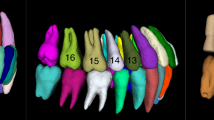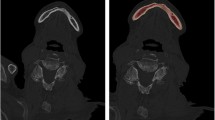Abstract
Most of the dental implant planning systems implement 3D reconstructions of the CT-data in order to achieve more intuitive interfaces. This way, the dentists or surgeons can handle the patient’s virtual jaw in the space and plan the location, orientation and some other features of the implant from the orography and density of the jaw. The segmentation of the jaw tissues (the cortical bone, the trabecular core and the mandibular channel) is critical for this process, because each one has different properties and in addition, because an injury of the channel in the surgery may cause lip numbness. Current programs don’t carry out the segmentation process or just do it by hard thresholding or by means of exhaustive human interaction. This paper deals with the validation of fuzzy connectedness theory for the automated, accurate and time efficient segmentation of jaw tissues.
This work has been supported by the project MIRACLE (DPI2007-66782-C03-01-AR07) of Spanish Ministerio de Educación y Ciencia.
Preview
Unable to display preview. Download preview PDF.
Similar content being viewed by others
References
Reiser, G.M., Manwaring, J.D., Damoulis, P.D.: Clinical significance of the structural integrity of the superior aspect of the mandibular canal. Journal of Periodontology 75(2), 322–326 (2004)
Verstreken, K., Cleynenbreugel, J.V., Martens, K., Marchal, G., van Steenberghe, D., Suetens, P.: An image-guided planning system for endosseous oral implants. IEEE Transactions on Medical Imaging 17(5), 842–852 (1998)
Galanis, C.C., Sfantsikopoulos, M.M., Koidis, P.T., Kafantaris, N.M., Mpikos, P.G.: Computer methods for automating preoperative dental implant planning: Implant positioning and size assignment. Computer Methods and Programs in Biomedicine 86(1), 30–38 (2007)
Fütterling, S., Klein, R., Straßer, W., Weber, H.: Automated finite element modeling of a human mandible with dental implants (1998)
Stein, W., Hassfeld, S., Muhling, J.: Tracing of thin tubular structures in computer tomographic data. Computer Aided Surgery 3 (1998)
Kršek, P., Krupa, P., Cernochová, P.: Teeth and jaw 3D reconstruction in stomatology. In: Medical Information Visualisation - BioMedical Visualisation. IEEE Computer Society, Los Alamitos (2007)
Kang, H., Pinti, A., Vermeiren, L., Taleb-Ahmed, A., Zeng, X.: An automatic FCM-based method for tissue classification. Bioinformatics and Biomedical Engineering
DeBruijne, B., Ginneken, B.V., Niessen, W., Viergever, M., Wiro, J.: Adapting active shape models for 3D segmentation of tubular structures in medical images. In: Taylor, C.J., Noble, J.A. (eds.) IPMI 2003. LNCS, vol. 2732, pp. 136–147. Springer, Heidelberg (2003)
Rueda, S., Gil, J.A., Pichery, R., Niz, M.A.: Automatic segmentation of jaw tissues in CT using active appearance models and semi-automatic landmarking. In: Larsen, R., Nielsen, M., Sporring, J. (eds.) MICCAI 2006. LNCS, vol. 4190, pp. 167–174. Springer, Heidelberg (2006)
Udupa, J.K., Wei, L., Samaraeskera, S., Miki, Y., van Buchem, M.A., Grossman, R.I.: Multiple sclerosis lesion quantification using fuzzy connectedness principles. IEEE Trans. Medical Imaging 16
Udupa, J.K., Odhner, D., Tian, J., Holland, G., Axel, L.: Automatic clutter-free volume rendering for MR angiography using fuzzy connectedness. In: SPIE Proceedings Medical Imaging, vol. 3034
Udupa, J.K., Tian, J., Hemmy, D., Tessier, P.: A pentium PC-based craniofacial 3D imaging and analysis system. J. Craniofacial Surgery 8
Udupa, J., Samarasekera, S.: Fuzzy connectedness and object definition: Theory, algorithms, and applications in image segmentation. Graphical Models and Image Processing 58(3), 246–261 (1996)
Author information
Authors and Affiliations
Editor information
Editors and Affiliations
Rights and permissions
Copyright information
© 2009 Springer-Verlag Berlin Heidelberg
About this paper
Cite this paper
Lloréns, R., Naranjo, V., Clemente, M., Alcañiz, M., Albalat, S. (2009). Validation of Fuzzy Connectedness Segmentation for Jaw Tissues. In: Mira, J., Ferrández, J.M., Álvarez, J.R., de la Paz, F., Toledo, F.J. (eds) Bioinspired Applications in Artificial and Natural Computation. IWINAC 2009. Lecture Notes in Computer Science, vol 5602. Springer, Berlin, Heidelberg. https://doi.org/10.1007/978-3-642-02267-8_5
Download citation
DOI: https://doi.org/10.1007/978-3-642-02267-8_5
Publisher Name: Springer, Berlin, Heidelberg
Print ISBN: 978-3-642-02266-1
Online ISBN: 978-3-642-02267-8
eBook Packages: Computer ScienceComputer Science (R0)




